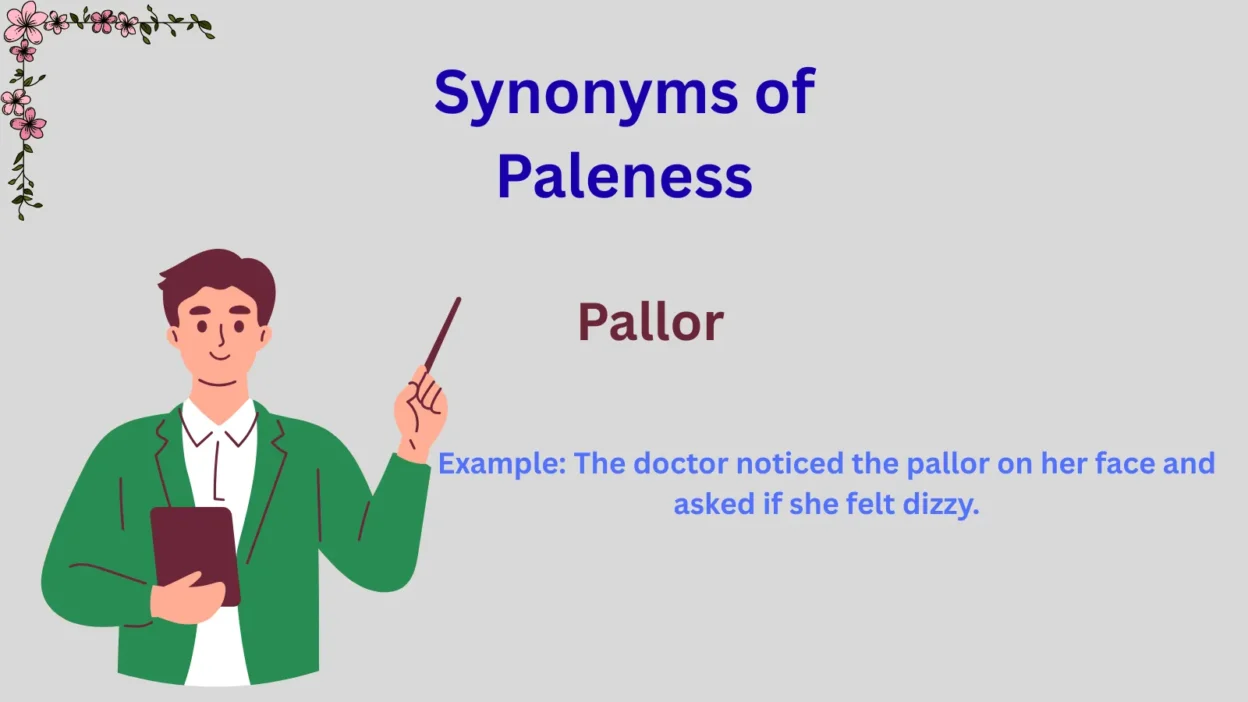Synonyms of paleness, such as pallor, pastiness, and ashen, describe a lack of color in someone’s skin or appearance. For example, “Her pallor showed she was feeling unwell,” or “His face turned ashen after hearing the news.” Each word highlights a slightly different nuance, from illness to shock or fear.
If you’re writing about health, emotions, or descriptive scenes, choosing the right synonym for paleness helps make your writing vivid and precise.
In this guide, you’ll learn the meaning and example sentences for each synonym of paleness, so you can describe someone or something looking pale with clarity and style.
30 Synonyms of Paleness and Their Uses
1. Pallor
Meaning: A medical or emotional paleness, often caused by illness, fear, or fatigue.
Example: The doctor noticed the pallor on her face and asked if she felt dizzy.
When to use: Best in formal or medical contexts.
2. Pastiness
Meaning: A doughy, unhealthy white tone of the skin.
Example: His pastiness revealed he hadn’t seen sunlight in weeks.
When to use: Useful for casual or descriptive writing with a slightly negative tone.
3. Ashen
Meaning: A grayish paleness, often from shock, grief, or terror.
Example: Her face turned ashen when she heard the tragic news.
When to use: Ideal for dramatic or emotional contexts.
4. Wan
Meaning: A faint, weak paleness that suggests fragility or exhaustion.
Example: He gave a wan smile despite his pain.
When to use: Poetic or literary tone, often linked with sadness or weariness.
5. Colorlessness
Meaning: The complete absence of natural color.
Example: The colorlessness of her cheeks alarmed the nurse.
When to use: Neutral description, works in both scientific and creative writing.
6. Ghostliness
Meaning: Extreme paleness that makes someone resemble a ghost.
Example: His ghostliness was unsettling in the dim light.
When to use: Metaphorical or gothic descriptions.
7. Bloodlessness
Meaning: Lack of blood circulation, suggesting lifelessness.
Example: The bloodlessness in his lips indicated severe anemia.
When to use: Medical or metaphorical contexts.
8. Faintness
Meaning: Suggests weakness and a loss of normal skin color.
Example: Her faintness was visible as she clutched the chair for support.
When to use: Works in both physical and emotional contexts.
9. Whiteness
Meaning: A natural or unnatural whiteness of skin.
Example: The whiteness of his face revealed his fear.
When to use: Neutral; adaptable to many contexts.
10. Lightness
Meaning: A lighter-than-usual skin tone.
Example: The lightness in her complexion suggested she was unwell.
When to use: Subtle or descriptive writing.
11. Ivory Tone
Meaning: Pale, smooth, and often considered elegant.
Example: Her ivory tone was admired in Victorian beauty standards.
When to use: Positive, poetic, or romantic contexts.
12. Sallowness
Meaning: Yellowish paleness often linked with poor health.
Example: The sallowness of his skin reflected months of malnutrition.
When to use: Negative or clinical descriptions.
13. Lividness
Meaning: A bluish or deathly pale shade.
Example: The lividness of his face suggested poor circulation.
When to use: Medical or gothic writing.
14. Grayness
Meaning: A dull, colorless appearance.
Example: The grayness of her skin frightened her family.
When to use: Neutral or somber descriptions.
15. Pasty Hue
Meaning: Doughy and lifeless skin tone.
Example: His pasty hue made everyone worry about his health.
When to use: Informal or descriptive narratives.
16. Bleakness
Meaning: A figurative or literal lack of warmth or color.
Example: There was a bleakness to her complexion that mirrored her mood.
When to use: Literary or symbolic contexts.
17. Sickliness
Meaning: A pale look suggesting chronic illness.
Example: His sickliness was impossible to ignore.
When to use: Negative, medical, or character description.
18. Waxiness
Meaning: A pale, smooth, and unnatural skin tone resembling wax.
Example: Her waxiness made her look like a doll.
When to use: Eerie or unsettling descriptions.
19. Ethereality
Meaning: Pale beauty that appears delicate or unearthly.
Example: Her ethereality captivated the audience during the play.
When to use: Poetic or positive, often romantic.
20. Alabaster
Meaning: Pure, pale whiteness, often seen as beautiful.
Example: The alabaster of her skin glowed in the moonlight.
When to use: Poetic, romantic, or artistic descriptions.
21. Drabness
Meaning: Lack of vibrancy, dull and pale.
Example: The drabness of his appearance reflected his low spirits.
When to use: Figurative or mood-driven writing.
22. Peakedness
Meaning: A sickly, pale appearance.
Example: His peevishness worried his mother.
When to use: Informal or conversational contexts.
23. Blood-drained Look
Meaning: Extreme paleness from shock or fright.
Example: She had a blood-drained look after the accident.
When to use: Dramatic or visual writing.
24. Dimness
Meaning: A lack of glow or natural color.
Example: The dimness of her cheeks showed exhaustion.
When to use: Figurative or subtle descriptions.
25. Fairness
Meaning: Light skin tone, often considered attractive.
Example: Her fairness was admired in old poetry.
When to use: Neutral or positive, but cultural sensitivity is important.
26. Anemia
Meaning: A medical condition resulting in paleness.
Example: His anemia left him pale and tired.
When to use: Strictly medical or clinical contexts.
27. Chalkiness
Meaning: A pale, chalk-like appearance.
Example: The chalkiness of her skin suggested fever.
When to use: Negative or descriptive writing.
28. Opacity
Meaning: Lack of translucency, dull paleness.
Example: The opacity of his face reflected poor health.
When to use: Figurative or artistic contexts.
29. Coldness
Meaning: Pale skin tone associated with lifelessness or low warmth.
Example: The coldness of her hands and cheeks startled him.
When to use: Emotional or symbolic writing.
30. Ghastliness
Meaning: Horrifying paleness, often associated with fear or death.
Example: The ghastliness of his expression frightened the children.
When to use: Gothic, horror, or dramatic descriptions.
Choosing the Right Synonym for Paleness
- Medical/Clinical Tone: Use pallor, anemia, sallowness, bloodlessness.
- Literary/Poetic Tone: Use wan, alabaster, ethereality, ivory tone.
- Negative/Unhealthy Tone: Use chalkiness, pastiness, sickliness, peakedness.
- Dramatic/Gothic Tone: Use ashen, ghostliness, ghastliness, lividness.
- Neutral Descriptions: Use whiteness, lightness, fairness, grayness.
Cultural context matters too: fairness may be considered positive in some traditions but can carry problematic connotations in discussions of beauty standards. Similarly, alabaster and ivory tones are best in artistic or romantic contexts, not medical ones.
Conclusion :
Synonyms of paleness, such as pallor, pastiness, and ashen, help describe someone or something looking unusually light or colorless. Each word highlights a slightly different shade—pallor often shows illness, pastiness suggests dullness, and ashen can imply shock or fear.
Using these synonyms makes your writing more precise and vivid. They let you convey physical condition, emotional impact, or atmospheric effect clearly. Whether in storytelling, description, or observation, these words give depth and detail to the simple idea of paleness.



